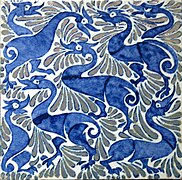William De Morgan

William Frend De Morgan (born November 16, 1839 in London , † January 15, 1917 ibid) was a British artist of the Arts and Crafts Movement and writer .
Life
De Morgan was born into a family of French Huguenots . His father, Augustus De Morgan , was the first mathematics professor at the newly formed University College London . His mother, Sofia Elizabeth Frend, was a suffragette who worked with Elizabeth Fry in the early 19th century for prison reforms, religious freedom and women's suffrage.
In 1859 De Morgan was accepted into the Royal Academy Schools . There he studied together with Frederick Walker and Simeon Solomon . Henry Holiday , who was among his circle of friends, introduced him to the artist and poet William Morris . After this meeting, De Morgan turned to the decorative arts and began to experiment in the field of stained glass.
In 1863, William Morris, William De Morgan and the painter Edward Burne-Jones met. Since Morris was not very successful in the design of ceramic objects, De Morgan took over the tile production in his company. He soon started designing his own tiles and worked with Morris, with whom he became friends, for many years.
De Morgan was married to the painter Evelyn De Morgan , who cultivated the so-called " Pre-Raphaelite " style.
Creative phase
- The Arab Hall in Leighton House
- De Morgan was commissioned by Frederic Lord Leighton to furnish the Arabic hall of his house with the Turkish, Persian and Syrian tiles that Lighton had collected during his travels. The architect George Aitchison designed this hall . Working with oriental ceramics and the diverse patterns of the Middle East influenced De Morgan's later work.
- P&O
- Between 1882 and 1900 he was commissioned by the British shipping company P&O to design the tile decor for the interior of twelve new ships of the line. The ceramics represented, for example, imaginative landscapes or the cities and countries of the travel destinations of the P&O liners. De Morgan also made designs for other ships, for example the “ Livadia ” for the ship of Tsar Alexander II of Russia . He continued his work until 1904, albeit with waning success in the end.
- Ceramic work
Fonts (selection)
Due to illness, De Morgan spent some time with his wife in Florence. At the age of 65, he began to write novels that became bestsellers, so that he could use the proceeds to secure a living for himself and his wife. As a versatile creative person, he also developed telegraph codes, constructed new pottery furnaces, sketched ideas for mills and sieves, worked on a new gearbox for bicycles and developed his own system for money accounts.
- Novels
- Joseph Vance. Grosset & Dunlap, New York 1906, OCLC 5107112 .
- Alice-for-Short. Henry Holt and Company, New York 1907, OCLC 3282865 .
- with Bruce Rogers: It Never Can Happen Again. Henry Holt and Company, New York 1909, OCLC 364168 .
- An Affair of Dishonour H. Frowde, Toronto 1910, ISBN 0-6657-5206-7 .
literature
- AMW Stirling: William De Morgan and his wife. Henry Holt and Company, New York 1922, OCLC 365096 . in the Internet Archive - online
- Rob Higgins et al: William de Morgan: Arts and Crafts Potter . Shire Library, 2010, ISBN 978-0-7478-0738-4 , p. 64.
- William Gaunt, Maxwell David Eugene Clayton Tribe: William De Morgan. Studio Vista, London 1971, ISBN 0-2897-0141-4 .
- William Gaunt, Maxwell David Eugene Clayton tribe: William De Morgan: Pre-Raphaelite ceramics. New York Graphic Society, Greenwich, Conn. 1971, ISBN 0-8212-0390-8 .
Web links
- William De Morgan at Google Arts & Culture
- William Frend De Morgan on artmagick.com (biography, English)
- William De Morgan: An Introduction. on victorianweb.org (biography, English)
Individual evidence
- ↑ a b c d William De Morgan on demorgan.org.uk, last accessed June 29, 2019.
- ^ Leighton House Museum , last accessed June 29, 2019.
- ^ History of the House , last accessed June 29, 2019.
| personal data | |
|---|---|
| SURNAME | Morgan, William De |
| ALTERNATIVE NAMES | Morgan, William Frend De (full name) |
| BRIEF DESCRIPTION | British artist |
| DATE OF BIRTH | November 16, 1839 |
| PLACE OF BIRTH | London |
| DATE OF DEATH | January 15, 1917 |
| Place of death | London |



